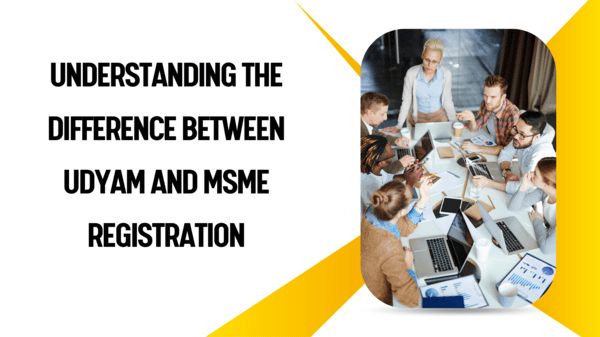Introduction:
In the world of business, especially in India, small and medium enterprises play a pivotal role in the economy’s growth. To support and streamline their operations, governmental initiatives like Udyam and MSME Registration have been established. However, there’s often confusion about whether these registrations are synonymous or distinct entities.
Is Udyam and MSME Registration the Same?
Udyam registration and MSME registration, though interconnected, are not the same. Here’s a breakdown of their differences:
Name and Implementation:
-
Udyam Registration: Introduced in July 2020, Udyam registration replaced the earlier MSME registration process. It aims to simplify and streamline the registration process for micro, small, and medium enterprises.
-
MSME Registration: This was the previous registration process that identified and categorized micro, small, and medium enterprises based on investment in plant and machinery or equipment.
Eligibility Criteria:
-
Udyam Registration: Considers both the investment in plant and machinery or equipment and turnover for classification.
-
MSME Registration: Used to classify enterprises solely based on the investment in plant and machinery or equipment.
Registration Process:
-
Udyam Registration: Involves self-declaration of information through an online portal. It emphasizes ease of registration and relies on the self-certification of enterprises.
-
MSME Registration: The earlier process required detailed documentation and verification, making it relatively more complex compared to Udyam registration.
Benefits and Support:
Both Udyam and MSME registrations offer similar benefits such as access to government schemes, subsidies, and easier access to loans. However, Udyam registration aligns with newer policies and may have certain advantages or updates over the previous MSME registration system.
Classification Criteria:
-
Udyam Registration: Classifies businesses based on their turnover and investment in plant and machinery or equipment. Micro-enterprises have a turnover up to Rs. 5 crore and an investment up to Rs. 1 crore. Small enterprises have a turnover between Rs. 5 crore and Rs. 50 crore, and an investment between Rs. 1 crore and Rs. 10 crore. Medium enterprises range from a turnover of Rs. 50 crore to Rs. 250 crore and an investment from Rs. 10 crore to Rs. 50 crore.
-
MSME Registration: Classified enterprises based only on the investment in plant and machinery or equipment. Micro-enterprises had an investment up to Rs. 25 lakh, small enterprises ranged between Rs. 25 lakh and Rs. 5 crore, and medium enterprises invested between Rs. 5 crore and Rs. 10 crore.
Validity and Renewal:
Udyam Registration: Provided with a unique Udyam Registration Number (URN) and is valid for a lifetime. However, enterprises must update their information regularly to maintain accuracy.
MSME Registration: Required renewal after a certain period, usually every few years, adding to administrative tasks for businesses.
Documentation and Registration Process:
Udyam Registration: Simplifies the process by requiring minimal documentation. Enterprises need to provide basic details such as Aadhaar number, PAN (Permanent Account Number), and other business-related information for registration.
MSME Registration: Previously, the registration process involved more extensive documentation, including business licenses, certifications, and other detailed paperwork. The process was relatively more time-consuming and complex.
Global Recognition and Integration:
Udyam Registration: Aims to enhance global recognition and integration for Indian small and medium enterprises by aligning with international standards. The updated approach with Udyam registration could potentially facilitate better global collaborations and partnerships.
MSME Registration: While it served its purpose domestically, MSME registration might not have had the same level of international recognition or alignment with global standards due to its earlier framework.
Government Initiatives and Support:
Udyam Registration: Tied directly to recent government initiatives such as the Atmanirbhar Bharat Abhiyan and various relief measures during economic disruptions caused by events like the COVID-19 pandemic.
MSME Registration: While MSME registration facilitated access to government schemes and subsidies, Udyam registration might offer more up-to-date and tailored benefits in alignment with the evolving economic landscape and policies.
Digitalization and Accessibility:
Udyam Registration: Emphasizes digitalization and accessibility through an online portal, making it easier for businesses in remote areas or with limited resources to register and access benefits.
MSME Registration: The earlier process might have faced challenges in terms of accessibility and might not have been as user-friendly as the current online Udyam registration portal.
Impact on Government Policies:
Udyam Registration: Being the updated version, Udyam registration aligns with newer government policies and initiatives, ensuring that registered enterprises have access to the latest schemes and benefits.
MSME Registration: While still recognized and valid, MSME registration might not align with the latest policy changes or may not offer the same level of benefits as Udyam registration.
Understanding these nuances between Udyam and MSME registrations can help businesses make informed decisions when it comes to choosing the appropriate registration for their specific needs. The shift from MSME to Udyam registration signifies a move towards a more streamlined and inclusive system that considers turnover alongside investment, making it more comprehensive and relevant in the current business landscape.
Regardless of the registration chosen, the primary objective remains consistent: to provide support, incentives, and avenues for growth to the backbone of the Indian economy—small and medium enterprises. Businesses should evaluate their eligibility criteria, operational scale, and future growth prospects to make the most suitable choice between Udyam and MSME registrations and harness the benefits offered by the government for their sustainable development.
Note: Now Print Udyam Certificate through udyam portal.
Conclusion:
In conclusion, Udyam registration and MSME registration differ in their approach, criteria, and process, though they both serve the purpose of supporting and promoting small and medium-sized enterprises. Udyam registration, being the updated version, encompasses a broader aspect by considering turnover along with investment, simplifying the registration process, and aligning with current government initiatives. Understanding these differences is crucial for enterprises to choose the appropriate registration that best suits their needs and enables them to leverage the benefits provided by the government for their growth and development.







